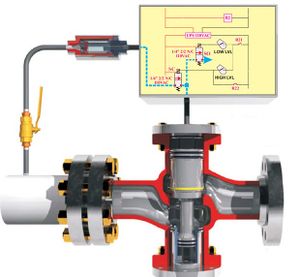Level Limit Valves
The invention concerns a Level Limit Valve for the fuel tank of a vehicle. Such Valves serve the purpose, that upon the filling of the fuel tank, the filled quantity of the fuel is limited. The proposed level limit valve possesses a valve body which can be positioned within the fuel tank at the end of a filling pipe. The valve body is equipped with an intake port which is connectable with the said filling pipe and an outlet port emptying into the interior of the fuel tank. Further, in the valve body is found a flap , which is pivotally movable between a position tightly sealing the outlet port and a position wherein this is opened. The float is movably connected to said flap by means of a lever rod . The lever rod penetrates the outlet port at least in the opened position of the flap and is connected by means of linkage with that outer side of the flap which is proximal to the outlet port .
A level limit valve for the fuel tank of a motor vehicle, the valve comprising: a valve body which can be positioned inside the fuel tank on the end of a fuel filling pipe, the valve body having an inlet port connectable to the filling pipe and an outlet port into the interior of the fuel tank; a float carrier attached to a downstream end of the valve body; a flap disposed in the valve body which is pivotally secured between a closed position which tightly closes the outlet port and an opened position which opens the outlet port; a lever rod connected to an outer side of the flap; a float movably connected to the flap via the lever rod for pivotally moving the flap, the lever rod penetrating through the outlet port when the flap is in the opened position, a central axis of the valve body and a pivot axis of the flap extending in an essentially horizontal direction, the float being disposed on the top of the carrier and being pivotally mounted to the carrier via a linkage so as to be vertically movable, the float carrier defining a centrally located opening through which the lever rod extends; wherein the valve body is essentially in the form of a tube section, whereby on the end surface facing fuel flow, a transverse wall is present, the wall containing the outlet port, on the inside of which a sealing edge is placed which peripherally encompasses the outlet port and coacts with the flap; and wherein two detent clips are located on an end of the inlet fitting extending in the direction of fuel flow, the inlet fitting being connected to the filling pipe and connected to the inlet port of the valve body, the detent clips protruding through the inlet port into the interior chamber of the valve and fixing the pivoting pins in the bearing seats.
In the case of conventional valves, the flap is supported with a pivoting axle in the valve body, which extends outward, through provided openings in the valve body wall. The outward extending ends of the pivoting axles are respectively movably connected with the float by means of a lever arm.
A disadvantageous aspect in the case of the conventional level limit valves, is that the fuel, suddenly blocked in entry by the shutting flap, fills up the pipe in a very short time and spills out through the inlet fitting. This gives the person attending the gas pump the impression, that the tank is not yet completely full, and as a result, must still be provided with more fuel, or he makes an effort to continue feeding until the gas pump display shows a nice round number. In spite of the use of a level limiting tank valve, measures must be taken, so that in spite of repeated topping-off efforts no fuel can enter into an associated, activated carbon filter through the air vent lines. The active carbon loses its effectiveness by contact with liquid fuels.With the protection of the activated carbon filter in mind, the purpose of the invention is to propose a level limit valve, which avoids this disadvantage.
